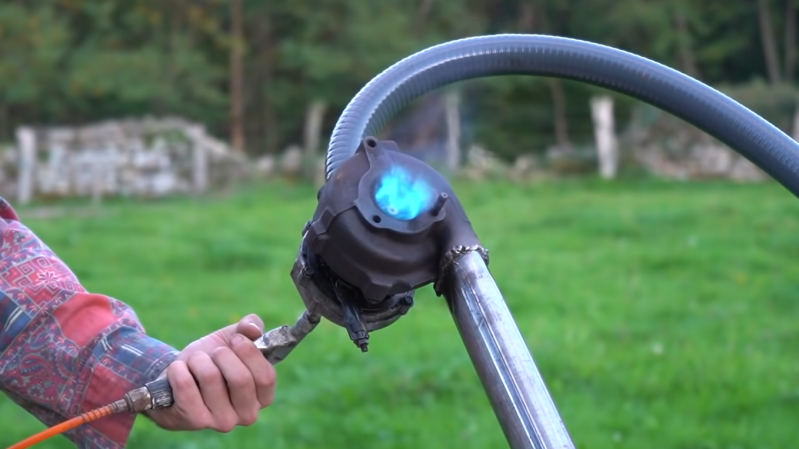Turbochargers as used on cars bear some similarities with jet engines. Fundamentally, both contain a turbine that harvests energy from hot gas, using it to spin a compressor which sucks in fresh air for combustion. Thus, turning a turbocharger into a jet engine is entirely possible, and [HRom] decided to have a crack at it.
The build starts with a turbo that appears to have been used on a diesel engine from the Volkswagen group. The first step was to cut the integral exhaust manifold off the turbo housing. A combustion chamber is then added which takes in fresh air from the compressor housing, and delivers hot combustion products to the turbine inlet. The homebrewed jet engine burns propane as fuel, introduced into the chamber via a nozzle.
The initial test failed as combustion was occurring at the turbine exhaust rather than in the combustion chamber, likely due to the lack of a proper ignition source inside the combustion chamber. A redesign employed a bigger combustion chamber built out of a fire extinguisher, with smouldering wood pellets inserted inside to get the injected propane burning.
The redesign works, and the turbocharger jet engine releases a thunderous scream as it turns at ever-increasing speed. However, with no oiling system or any way of controlling air or fuel flow in the engine, it eventually stops in a huge puff of smoke. Regardless, the engine did run in a sustained manner even if the ignition method was rudimentary.
We’ve seen similar builds before, and the rudimentary construction means they’re typically nowhere near being flight-weight engines. They are incredibly cool, however, and a great way to learn the basic principles of how jet engines work. Video after the break.
[Thanks to Francisco José Lazur for the tip!]
















I think it was wise of him to go hide behind the truck – but it was definitely exciting as a first try… WOW
There are so many Youtube videos of people building these turbine engines and even a few guys have constructed air drive transmissions and other peripherals. The KEY to making this work is in the combustion chamber design and the ignition system. A successful electronic ignition system has been designed by several experimenters. Some have developed electric motor starting systems, oil pump drive systems to lubricate the turbine and even constructed after burners for them. They are totally cool and I have watched a lot of them using small turbos from small car engines to larger turbos from huge Diesel engines. They have used them on go carts and even one guy used a riding mover frame. I saw one project that a fellow used a motorized tool cart from a large industrial plant. I have seen videos of guys going close to a hundred MPH using these homebuilt turbine jet engines. There’s really no reason a small aircraft couldn’t be powered by such a build. Of course flight time would likely be pretty short.
…but have you seen one run from wood for fuel?!? I was thinking the same thing about ignition in the combustion chamber until he loaded it up with wood pellets and was able to sustain combustion until it seized. That was pretty cool. I was expecting wood gas.. not full on, load the combustion chamber up
NYE Thermodynamics Corporation NT/6, https://www.nyethermodynamics.com/nt6/index.html
“Introducing the worlds’ first wood burning generator / Turbine wood-stove”
Merry Christmas all!
Entertaining for a bit..
The “Turbo into Turbine” has been done for years.
Dr. Marius Paul (RIP) designed APU packages for the military using modified turbos by attaching a combustion chamber.
Design a box around it, and sell it.
And no, none of those would run on wood. (Pellets or 2x4s)
Very cool, but 2 lessons :
1) Turbos need oil. Even Colin Furze’s cheap-ass turbo had a crude oil feed, though in this case maybe the turbo seized, preventing further carnage..
2) Solid-fuel engines are hard to turn off.
A coal-fired turbo would be neat.
Konegsburg built single cycle turbines that would run on crude oil. (That’s ugly for fuel)
I used the same for landfill methane, but I needed diesel to fire it up. Once lit, I switched over the the lower BTU CH4.
I’m not interested in a jet engine so much as I am a gas turbine APU that could turn gasoline into electricity more efficiently than a reciprocating piston engine can. Such a thing would be quite beneficial to the electric car market by relieving their dependence on charging infrastructure. This would, I imagine, improve the market adoption of electric (technically hybrid, I guess) cars, which would increase the demand for charging stations, and thereby accelerate our transition from fossil fuels.
Add the MGUH from F1, and you got a great EV petrol engine🤣
The problem is, small simple gas turbines are less efficient and cost more per kW than piston engines. Their only advantage is power to weight ratio. Typically used gas turbines are big and costly, but yeah, they are more efficient.
Wrong, gas turbines are the cheapest practical source of electricity. Otherwise, power plants would be using piston engines.
I remember when there was a prediction that cars might eventually use gas turbines in conjunction with electric motors as a hybrid system, but in practice, Atkinson cycle engines offer similar efficiency boost at a much lower cost. That said, there was a hybrid version of the EV1 with a gas turbine that got 80 MPG.
Not too shabby for a basic build. His design for the combustion Chamber was lacking an inner chamber to keep the flame from blowing out. Then he.could meter the fuel to get a steady run w/out flame-out
Still, pretty cool. With another half turbocharger he could run a generator
The inner “Flame Tube” is designed with holes around and down the length,
to bleed air in and keep the tube from melting.
That’s the way it worked on mine.